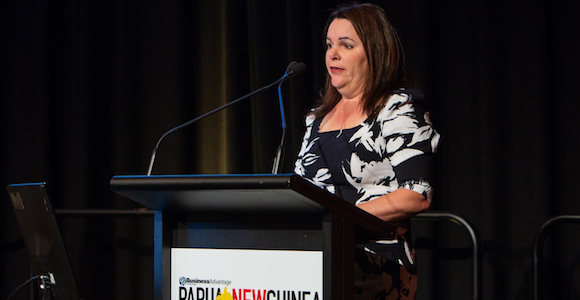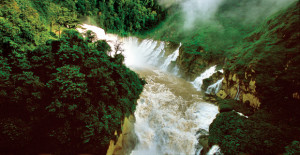Carolyn Blacklock, the acting Managing Director of PNG Power, says the money that will come from the Papua New Guinea Electrification Partnership established at APEC will greatly assist the roll-out of electricity. She says PNG Power has sharply increased the number of connections and will concentrate on hydropower.

Carolyn Blacklock, acting MD of PNG Power. Source: BAI
The Papua New Guinea Electrification Partnership has been struck with Australia, Japan, New Zealand and the United States. It has the goal of connecting 70 per cent of the population to electricity by 2030.
Currently only about 13 per cent of Papua New Guinea’s population have reliable access to electricity.
‘What it says is: if you have good governance, they will back you,’ Blacklock told business leaders last week.
‘The PNG Electrification Partnership is not loans; it is not tied aid.
‘It is real money, starting with US$45 million from January next year. We don’t have to go through hoops.
‘This Electrification Partnership stops PNG Power from having to borrow money.’
‘We will procure, and they will come and check we have done the connections.
‘Then they will give us the money. It is that simple.’
Piecemeal

Hydropower is a low cost option
Blacklock says the development of PNG’s electricity grid tends to be implemented piecemeal ‘with district money’.
It means new funding continuously has to be found.
‘This is admirable, but it is not going to get up the development of PNG that we need.
‘This Electrification Partnership stops PNG Power from having to borrow money.
‘We can’t afford the K3.6 billion price tag to electrify our country.
‘We also do have a challenge in that when we do need to spend our money, we need to make sure we reduce the tariff [to customers].
‘We can only get to about half more customers on the grid than we have today before people stop being able to afford it.
‘Next year we are going to set ourselves a target of 30,000 connections.’
‘If you are a subsistence farmer, you cannot afford it. We will be able to connect you, but that line will remain un-energised.
‘We have to bring this tariff down. So we are going to spend our money on making sure we are becoming super efficient in our power generation.
Connections
Blacklock says PNG Power has been doing about 2500 connections a year for the ten years to 2017.
‘This year, as of October, we have done 16000—and we expect it to be 19,000 by the end of the year.
‘The company has also been concentrating on re-establishing its low cost hydropower installations.’
‘Next year, we are going to set ourselves a target of 30,000 connections. We are going to do that across the country.’
Blacklock believes the workforce at PNG Power is up to the job.
‘If you give people a chance to go out and do what they believe their job is, which is actually connect Papua New Guineans to power, you can see that they can do it.’
Self-esteem
Blacklock says PNG Power is now supplying more power to Harmony Gold in Hidden Valley and has also increased its supply to Mainland Holdings.
The company is negotiating with Newcrest over the Wafi-Golpu mine.
‘We spoke with Wafi-Golpu about six months ago on the back of the notion that PNG Power could supply cheaper power than if they built their own.
‘We are still proving to them that this is possible, but with a blended tariff it is probably going to be in the order of six US cents a kilowatt hour cheaper than what they can do.’
Blacklock says the company has also been concentrating on re-establishing its low cost hydropower installations.
‘If you were wondering why PNG Power wasn’t making any money, it was in part because we have an environment where we are burning diesel and fuel oil, rather than fixing up our own hydro.
‘We need to think of ourselves as the institution that underwrites the future of our country.
‘Self-esteem has come back.’








Speak Your Mind